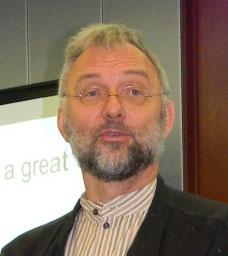
Thomas Zemb was awarded the 2017 Overbeek Gold Medal in recognition of his outstanding contributions to colloid and interface science, including the establishment of equations of state of colloids; investigation of colloidal forces between nano-objects, and discovery of new catanionic materials. He got his Bachelor degree as nuclear physicist, via a diploma work at the ETH-Zurich, and then he turned to biophysics, with a subsequent Master’s degree at University Paris VI, with experimental work in enzymology at the Institute “Pasteur”. His definitive orientation towards physical chemistry dates back to 1979 at CEA in Saclay. Till 1985 he investigated the self-assembly in micellar and microemulsion structure by combining X-ray and neutron scattering. Three results from that time are now in textbooks: (i) The evidencing and the origin in electrostatics of the variation of mass of ionic micelles with concentration. (ii) The “bicontinuous structures” in microemulsions are not equivalent, but besides globules and a structure reminiscent of spinodal decomposition, two other microemulsion structures are possible and found in lots of microemulsions: randomly connected cylinders and randomly connected locally lamellar structures, now called biliquid foams and sponge phases. (iii) Establishing the high degree of disorder in the core of micelles by high resolution X-ray and Neutron scattering, a result independently obtained by him in France, in Australia (Marcelja) and in the US (Dill and Flory) and explaining the high polar reactivity observed for apolar solutes supposed to be solubilized “in the core” of these aggregates.
From 1985, he spent three years as visiting fellow in Australia, under the guidance of B W Ninham and J W White, generalizing and unifying microemulsion models, which at the time were incompatible with phase diagrams and observed electrical conductivities. He there developed small angle X-ray scattering apparatus which are unique in performance worldwide. These experimental developments have enabled him to measure interparticle distances as a function of osmotic pressure- i.e. the equation of state of colloids, the core of the goal of research of Thomas Zemb in the last fifteen years. In 1992, he was asked to create a laboratory devoted to “Chimie de la Matière ultra-divisée” in Saclay, known as Saclay colloid group, He concentrated on the investigation and determination of colloidal forces between nano-objects, colloids, or self-assembled aggregates, by means of determination of phase diagrams and equations of state. To distinguish equations of state with a precision sufficient to discriminate between old DLVO and more recent theories, he and his team combined precise measurement of the chemical potential of water, i.e. osmotic pressure, with the small angle X-ray scattering. The first complete equations of state of colloidal crystals, demonstrating experimentally that the different propositions of long range attractive electrostatics are wrong, has been published by the team of T. Zemb in 1999, as well in the no-salt as in the added multivalent salt case.
During the search for robust self-assembled colloids, where equations of state and therefore the balance of intermolecular forces could be determined, he and his co-authors found that the simplest and most flexible system studied was the catanionic system, a mixture of anionic and cationic surfactants. In the absence of excess salt, colloidal interactions are unscreened, and new shapes of self-assembled colloids were observed. Nanodiscs of controlled size (Science 2001), virus-like self-assembled hollow icosahedra (Nature 2001). The thermodynamic and kinetic route to the formation of these aggregates could then be determined, as well as parts of the equation of state (PNAS, 2004). This new material has the highest elastic moduli ever measured for surfactant self-assembly (close to 1 GPa). The origin of this elastic modulus is the sandwich-like structure and can be efficiently modelled.
Thomas Zemb profited from the double culture of the French CEA: publication and basic research, but open to applications, in close collaboration with industry. His many original applied contributions have led to a CEA chemical engineering development program active since 2001 aimed to test, and predictively model the behavior of new self-assembling extracting surfactants at the nuclear production plant in Marcoule. This has led to the establishment of the Institute of Separation Chemistry in Marcoule (ICSM), that T. Zemb has built up as founding director. To continue his work on ion separation he received the ERC Advanced Award.
Among his most prestigious awards are the Prix Paul Pascal for physical chemistry of the Academie des Sciences (2003) and the Rhodia Prize of the European Colloid and Interface Society (2004), the Alexander von Humboldt Award and the Mercator professorship of the German Science Foundation (DFG).
He also has always been engaged with ECIS and in the colloidal EU COST Actions, taking part in most conferences, serving as ECIS president, working-group leader and workshop organizer, and as member of numerous committees.
